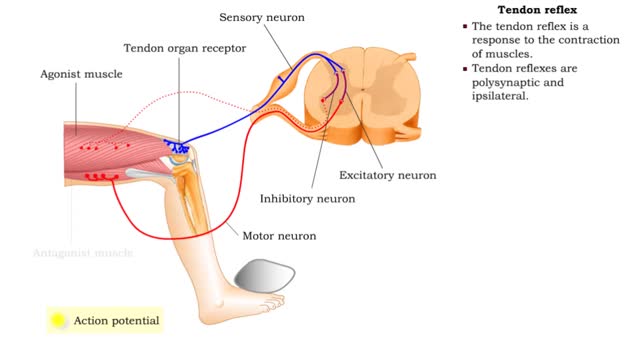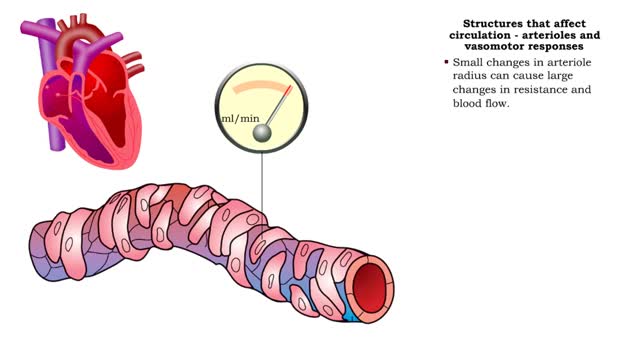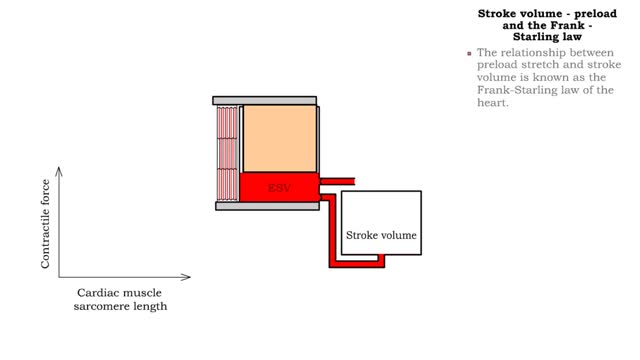Search Results
Results for: 'Muscle fibre'
Stretch reflex & Tendon reflex
By: HWC, Views: 11482
• The stretch reflex is a response to the stretching of muscles. It is monosynaptic and ipsilateral. • Stretching stimulates receptors in the muscle spindle of the agonist (stretched) muscle. • One or more action potentials are generated by the receptors and propagate along the axon of ...
Contraction cycle of a sarcomere
By: HWC, Views: 12177
• A single nervous signal releases Ca2+ ions into the sarcoplasm and initiates the contraction cycle. step 1. ATP hydrolysis • ATP provides the to move myosin molecules back into the energized configuration necessary to perform the power stroke. Step 2. Crossbridge attachment • Myosin...
Definitions of stroke volume, preload definition & Factors influencing stroke volume
By: HWC, Views: 11504
• Stroke volume is directly correlated with cardiac output-the greater the stroke volume the greater the cardiac output. • Stroke volume represents the difference in the amount of blood between: • the volume in the ventricles at the end of diastole (end-diastolic volume EDV); • the ...
Nervous pathway to the Neuromuscular (NMJ)
By: HWC, Views: 12168
• A nervous impulse, also called an action potential, starts from the brain or spinal cord to signal skeletal muscle cell contraction. Action potentials continue along a motor neuron to the muscle cell. • The signal to contract must cross a synapse - the neuromuscular junction (NMJ) - betwe...
By: Administrator, Views: 14499
An electrocardiogram (ECG or EKG) is a test that checks how your heart is functioning by measuring the electrical activity of the heart. With each heartbeat, an electrical impulse (or wave) travels through your heart. This wave causes the muscle to squeeze and pump blood from the heart. Sinoat...
Structures that affect circulation - kidneys and blood volume and skeletal muscle pumping
By: HWC, Views: 12371
• Kidneys regulate blood volume and blood osmolarity via salt and water reabsorption. • Increased reabsorption increases blood volume and venous return (and CO). • Decreased reabsorption Increases urine production, which decreases blood volume and venous return (and CO). • Systemi...
Structures that affect circulation - arterioles and vasomotor responses
By: HWC, Views: 11319
■ Small arteries and arterioles determine SVR. ■ Blood pressure drops significantly as blood passes through arterioles. ■ Decreasing arteriole radius and decreased wall elasticity are the main reasons for increased SVR. ■ Small changes in arteriole radius can cause large changes in ...
Stroke volume - preload, sarcomere length and Frank -Starling law
By: HWC, Views: 11304
• Sarcomere length affects muscle tension and the force of contraction. • Increased muscle stretch (increased sarcomere length) at the beginning of contraction increases tension produced during the contraction. • A more forceful contraction ejects more blood, thus increasing stroke volu...
Structures that affect circulation - arterioles and vasomotor responses and venous return
By: HWC, Views: 11750
■ Small arteries and arterioles determine SVR. • Blood pressure drops significantly as blood passes through arterioles. • Decreasing arteriole radius and decreased wall elasticity are the main reasons for increased SVR. ■ Small changes in arteriole radius can cause large changes in ...
Advertisement











